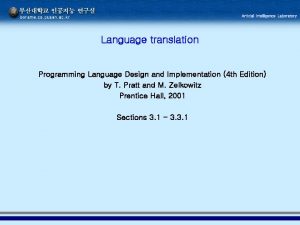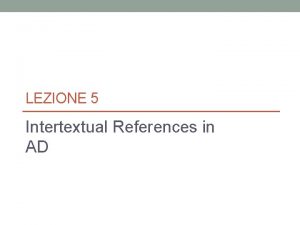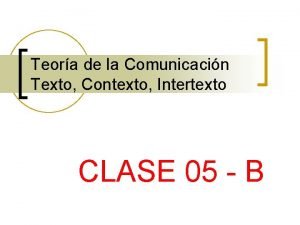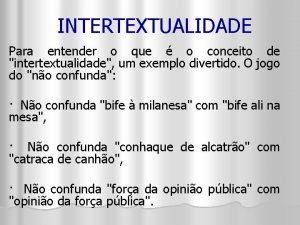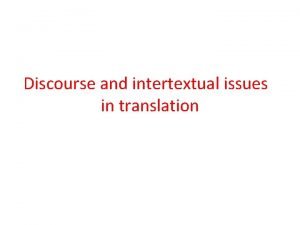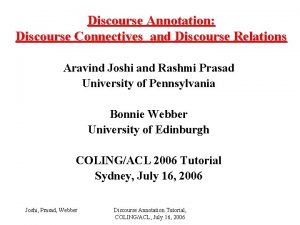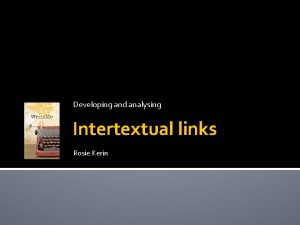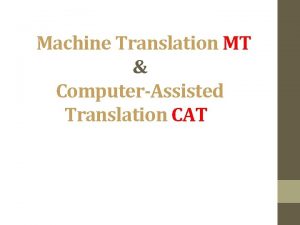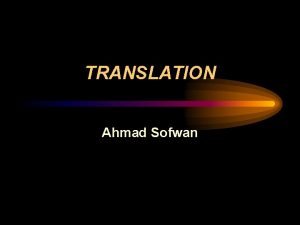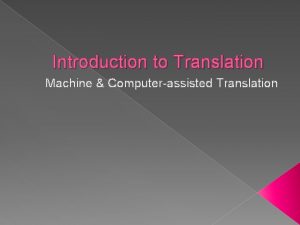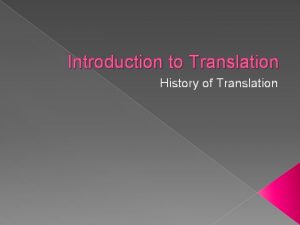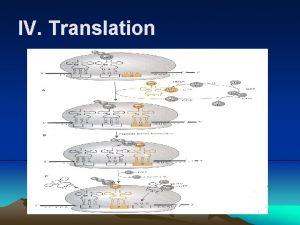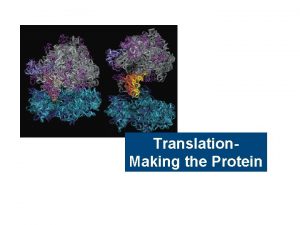Discourse and intertextual issues in translation The discourse





















- Slides: 21

Discourse and intertextual issues in translation

The discourse level: the textual variables considered on the discourse level are those that distinguish a cohesive and coherent text from a sequence of unrelated utterances. This level- the discourse level- is concerned with intersentential relations(relations between sentences) and relations between larger units such as paragraphs, etc.

For our purposes, however, it is sometimes • useful also to consider relations between parts of sentences on the discourse level (particularly clauses). This is particularly important with respect to Arabic as Arabic sentences are often extremely long, and the lack of consistent punctuation often makes it impossible to determine where one sentence ends in Arabic and another begins.

Cohesion and coherence : • It is useful to distinguish between two aspects • of discourse cohesion and coherence. Following Halliday and Hasan (1976), cohesion is the transparent linking of sentences by explicit discourse connectives such as then, so however and so on. These act as signposts pointing out the thread of discourse running through the text.

Cohesion is also realized by the use of features such as root repetition and lexical item repetition, in additions to features such as theme-rheme elements and main-subordinate elements. Coherence: Unlike cohesion coherence is not explicitly marked in a text: it is a thematic or emotional development running through the text. Consequently, all cohesive texts are coherent, but not all coherent texts are cohesive.

We can illustrate the difference with a simple example. I was getting hungry. I went downstairs. I knew the kitchen was on the ground floor. I was pretty sure the kitchen must be on the ground floor. I didn’t expect to find the kitchen so easily. I made myself a sandwich. I was getting hungry. So I went downstairs. Well. . . I knew the kitchen was on the ground floor. I mean, I was pretty sure it must be there. Still, I didn’t expect to find it so easily. Anyway, I made myself a sandwich. .

As can be seen from the two examples: Text 1 lacks intersentential connectives. It is still coherent due to the underlying chronological narrative structure. In text 2 thought is achieved by the use of connectives. Some of these connectives link sentences by explaining or commenting on the speaker’s actions: so, I mean, still, anyway. Others are instances of grammatical anaphora- that is the replacement of previously used words and phrases by expressions referring back to them; here the anaphoric elements are “it”(replacing the kitchen ) and “there’ replacing on the ground

As we mentioned before cohesion is realized by the use of features such as root repetition and lexical item repetition. Repetition in Arabic has two functions: 1. It may allow the writer to talk about closely related ideas, serving in this case much the same purpose as lexical variation does in English. 2. It may serve as cohesive text-building function, in much the same way as connectives do


Another area in which Arabic and English differ is their use of discourse connectives. In many genres , Arabic sentences are typically longer than English sentences, and sentences and clauses in Arabic are typically connected either ﺛﻢ ، ﻑ ، ﻭ by one of the three basic connectives or by the use of one of the secondary connectives such as ﺇﺫ ، ﺣﻴﺚ

Languages also differ in their use of punctuation as a cohesion marker. It should be remembered that Arabic traditionally made no use of punctuation, and that even now punctuation is often used in Arabic in ways which seem rather arbitrary. Even the use of punctuation marks such as full stops can be highly idiosyncratic, particularly in literary writing.

Sentence splitting: Since sentences in Arabic tend to be longer than sentences in English, it is quite frequently necessary to split up one Arabic sentence into a number of English ones.


Unfortunately such concerns are not unique to Kosovo though. We have seen struggles such as this in various countries, and have witnessed similar scenes of madness caused by religious fanaticism or extreme nationalism, but never on the scale which we saw in Bosnia. And yet, now we see it again, with redoubled force in Kosovo, whose population comprises some 90% Muslims, and whose natural right it is to demand some form of self-government. The Bosnians previously raised the issue of independence in the past, but eventually accepted a modest form of self-government at the Rambouillet talks. (Here a single Arabic sentence is relayed by four English sentences) .

Textual restructuring: It is the reorganizing of chunks of textual material in the TT in order to make them read more cogently. Sentence splitting may be regarded as oriented towards cohesion, in that it concerns the ways in which texts , in different languages, adopt different ways of linking material together. Textual restructuring, by contrast, is more oriented towards coherence; it concerns the ways in which languages typically organize their ideas differently from one another.


A more literal translation, e. g. ‘It fought against them, supported their opponents, and characterized them as godless ideologies’ seems odd in English, principally because it begins with the practical actions taken by the Saudis (‘fought against them’, ‘supported their opponents’) and then goes on to give the reason for these actions (‘characterized them as godless ideologies’)

It thus runs directly counter to the normal • tendency in English, which is to start by describing principles (in this case ‘characterized them as godless ideologies’) and then go on to describe the practical consequences of these principles (‘fought against them by funding their opponents’). This is the order of the restructured TT.

It is important to stress that the fact that the TT reorganizes this material does not mean that the Arabic ST is illogical; from the Arabic point of view, it might be argued that the ST clause ﻓﺤﺎﺭﺑﺘﻬﺎ ﻭﺩﻋﻤﺖ ﺧﺼﻮﻣﻬﺎ ﻭﻭﺻﻔﺘﻬﺎ ﺑﺎﻟﻜﻔﺮ has cogency because it represents a build-up of increasingly strong responses: i. e. Saudi Arabia not only fought these ideologies on its own behalf, it also went beyond this to actively support their opponents. Finally, and most strongly from an Islamic point of view, it characterized them as godless.

Paragraphing: Like punctuation, paragraphing can pose problems in Arabic/English translation. There are some generic considerations involved in paragraphing. For example, news report tend to have very short paragraphs, sometimes only a single sentence. Academic writing, by contrast, often makes use of extremely long paragraphs.

In Arabic, similar conventions for paragraphing to those of English are followed by many writers. However, one may come across paragraphing in Arabic which clearly does not follow English-type conventions. Under such circumstances, the translator will normally expect to reparagraph the TT according to the conventions of English.
 Discourse analysis in linguistics
Discourse analysis in linguistics Language design and translation issues
Language design and translation issues What is intertextual reference
What is intertextual reference Que es una relación intertextual
Que es una relación intertextual Vance joy riptide meaning
Vance joy riptide meaning Elementos intertextuales
Elementos intertextuales Parafrasear
Parafrasear Intertextualidade o que é
Intertextualidade o que é Communicative meaning in semantics
Communicative meaning in semantics Square root function transformations
Square root function transformations Voice translation-rule
Voice translation-rule Noun phrases
Noun phrases Hát kết hợp bộ gõ cơ thể
Hát kết hợp bộ gõ cơ thể Lp html
Lp html Bổ thể
Bổ thể Tỉ lệ cơ thể trẻ em
Tỉ lệ cơ thể trẻ em Voi kéo gỗ như thế nào
Voi kéo gỗ như thế nào Tư thế worm breton
Tư thế worm breton Alleluia hat len nguoi oi
Alleluia hat len nguoi oi Môn thể thao bắt đầu bằng chữ f
Môn thể thao bắt đầu bằng chữ f Thế nào là hệ số cao nhất
Thế nào là hệ số cao nhất Các châu lục và đại dương trên thế giới
Các châu lục và đại dương trên thế giới

